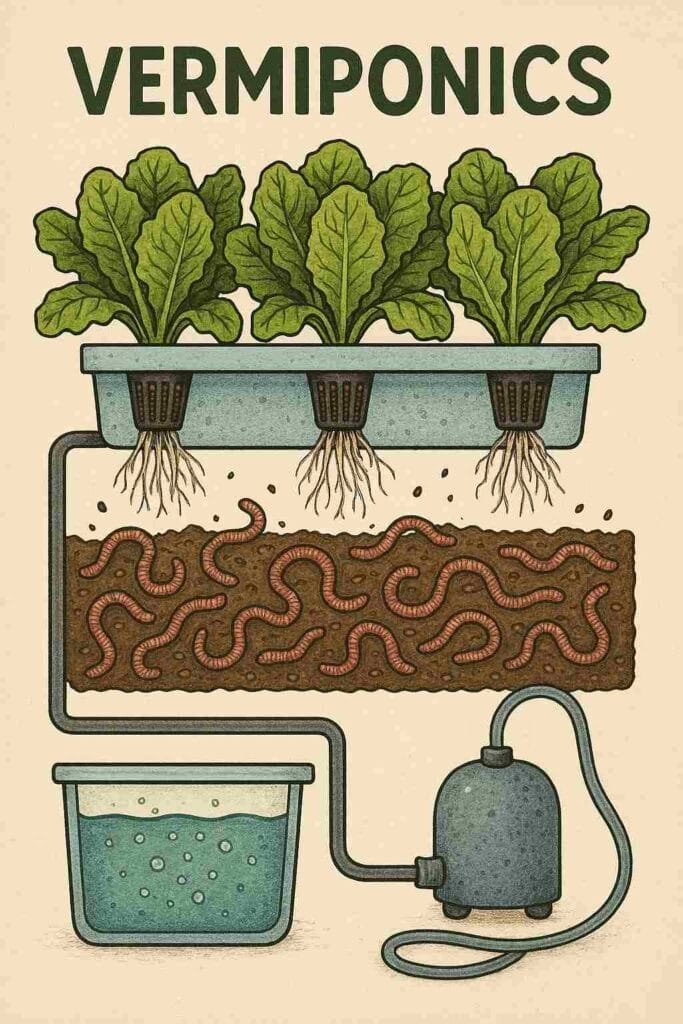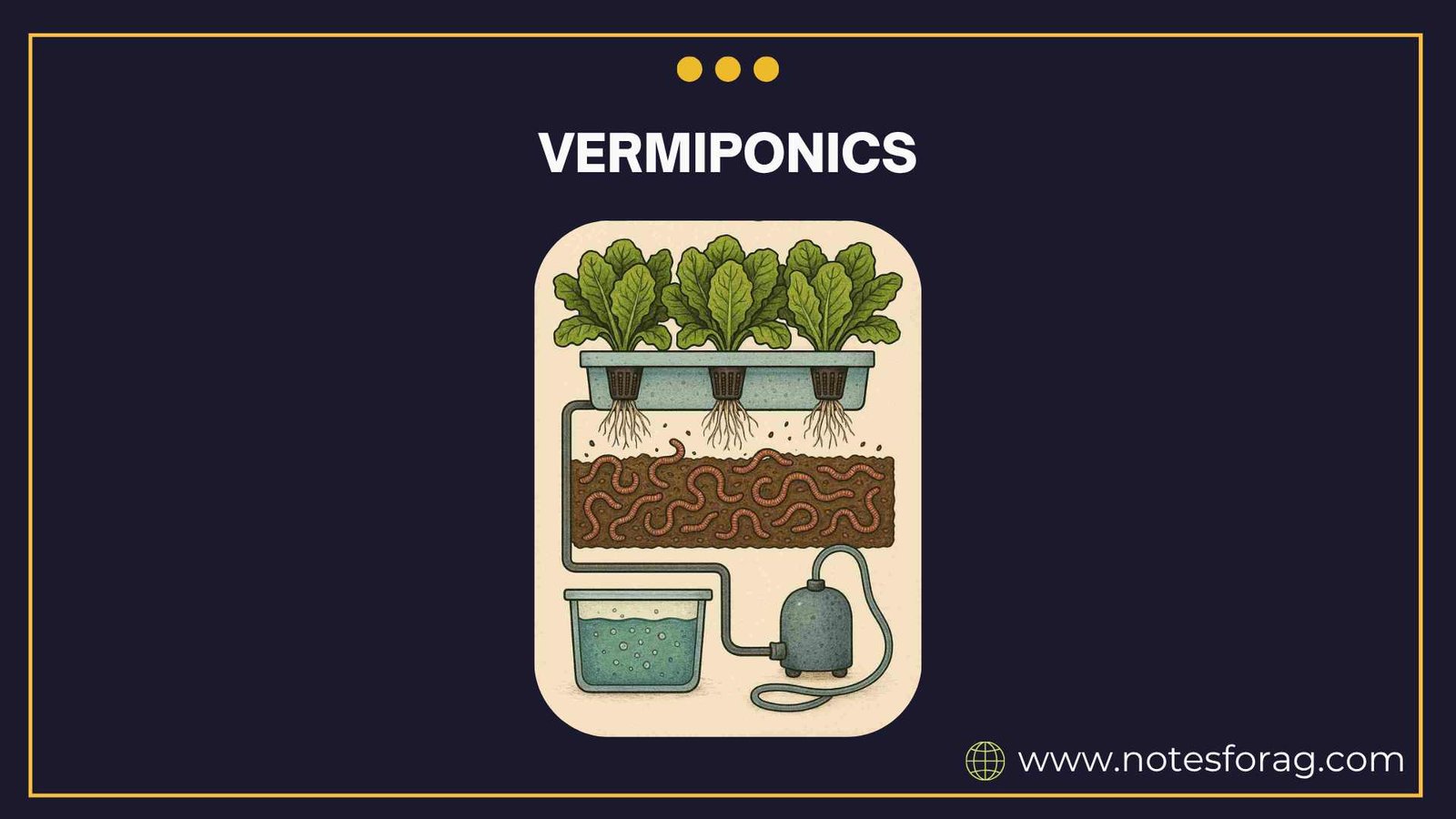Introduction
Vermiponics is an innovative and eco-friendly agricultural technique that combines vermiculture (worm farming) and hydroponics (soilless plant cultivation). This method uses the nutrient-rich water from worm composting systems to feed plants in a hydroponic setup. It creates a sustainable, closed-loop system that efficiently recycles organic waste into a highly productive farming method. It is ideal for urban gardening, small-scale farmers, and anyone looking to reduce waste and grow healthy food using natural processes.
What is Vermiponics?

Vermiponics is a form of integrated farming that merges two sustainable methods: vermiculture, where worms break down organic waste to produce nutrient-rich vermicompost and leachate; and hydroponics, a technique of growing plants in water without soil. In vermiponics, the liquid by-product (worm tea or leachate) is used as the primary nutrient source for hydroponically grown plants. This system supports plant growth naturally and reduces reliance on synthetic fertilizers.
Summary of Vermiponics
- Vermiponics is a sustainable farming method that combines vermiculture (worm composting) and hydroponics (soilless plant growth) to produce nutrient-rich, organic crops.
- It uses worm castings and compost tea as natural fertilizers, promoting healthy plant growth without synthetic chemicals.
- Vermiponics is eco-friendly, water-efficient, and suitable for both small-scale urban setups and larger sustainable agriculture systems.
Table of Contents
Components of Vermiponics System
1. Vermiculture Unit
This unit houses composting worms (usually red wigglers) that consume organic waste. The bin is designed to collect both solid vermicompost and the liquid leachate that drains through the system.
2. Leachate Collection Tank
The bottom of the vermiculture unit is designed to capture the leachate (worm tea). This liquid is rich in nutrients and serves as the main input for plant nutrition in the hydroponic component.
3. Hydroponic Grow Bed
Plants are grown in a soilless medium such as perlite, coconut coir, or clay pellets. This bed is fed with the leachate diluted with water to the appropriate nutrient strength.
4. Water Pump and Circulation System
A pump ensures the leachate is circulated from the collection tank to the hydroponic grow bed, allowing plants to absorb nutrients. Excess water drains back to the reservoir for reuse, creating a continuous loop.
5. Reservoir
This tank holds the diluted leachate and serves as the central water source for the hydroponic system. It helps maintain consistency in nutrient delivery.
Benefits of Vermiponic
1. Sustainability
Vermiponics recycles organic kitchen or garden waste through worms, reducing landfill pressure while producing nutrient-rich liquid for plant growth.
2. Chemical-Free Farming

The system uses natural worm leachate as plant fertilizer, minimizing the need for synthetic chemicals that harm the environment.
3. Improved Soil and Plant Health
Although soil is not used in vermiponics, the nutrient-rich solution enhances plant health and supports faster and more robust growth.
4. Water Efficiency
Vermiponics systems are closed-loop and reuse water, making them ideal for water-scarce areas or urban farming.
5. Compact and Scalable
These systems can be designed for small balconies or large farms, depending on the user’s goals and available space.
6. Higher Crop Yield
The readily available nutrients from vermileachate often lead to increased plant productivity and better quality produce.
Suitable Plants for Vermiponics
1. Leafy Greens
Spinach, lettuce, kale, and other leafy greens thrive in vermiponics because of their high nutrient demands and fast growth.
2. Herbs
Basil, mint, cilantro, and parsley respond well to vermiponic systems and maintain excellent flavor.
3. Fruiting Plants
Tomatoes, peppers, and strawberries can be grown, although they may require a more controlled nutrient balance.
4. Root Vegetables
With the right setup, crops like radish and beets can also be cultivated using vermiponics.
Setting Up a Vermiponic System
1. Build the Worm Bin
Use a plastic or wooden container with air holes and a drainage system. Add bedding material like shredded newspaper and introduce red wigglers. Feed them with chopped fruit and vegetable scraps.
2. Collect and Dilute Leachate
As worms break down waste, collect the leachate and store it in a container. Dilute the leachate with clean water (typically 1:10 ratio) before using it for plant feeding.
3. Prepare the Hydroponic Bed
Set up a hydroponic grow bed with your chosen soilless medium. Ensure it has drainage and is elevated above the reservoir to allow water circulation.
4. Connect Water Circulation
Use a pump to circulate diluted leachate from the reservoir to the plant roots. Make sure there is a return flow to maintain the water loop.
5. Monitor Plant and Worm Health
Regularly check pH, temperature, and nutrient concentration. Ensure worms are healthy and the system remains balanced.
Maintenance and Troubleshooting
1. pH Management

Maintain a pH range between 5.5 and 6.5 for optimal nutrient uptake. Use natural pH up/down solutions as needed.
2. Worm Care
Avoid overfeeding, maintain moisture, and provide good aeration to keep worms healthy. Remove any moldy or processed food waste.
3. Odor Control
Bad smells indicate imbalance. Add more dry bedding and avoid over-watering to reduce odor.
4. Nutrient Deficiency
Yellowing leaves or stunted growth may signal nutrient deficiency. Test and adjust leachate concentration or supplement with organic inputs.
5. Algae and Pests
Keep hydroponic beds covered to prevent algae. Use natural repellents for pests. Regular cleaning keeps the system hygienic.
Challenges of Vermiponic
1. Complex Setup
The combination of vermiculture and hydroponics may be tricky for beginners to manage without prior experience.
2. Leachate Variability
The nutrient content in worm leachate can vary, making it difficult to standardize plant feeding.
3. Temperature Sensitivity
Both worms and plants in hydroponic systems are sensitive to temperature changes, requiring careful monitoring.
4. Initial Cost
Although long-term savings are high, the initial setup may involve investment in pumps, tanks, and growing beds.
Future of Vermiponic
As interest in sustainable agriculture grows, vermiponics presents a promising method for growing food naturally and efficiently. Research is being done to standardize the use of worm leachate, automate systems, and adapt the technique for commercial farming. With increased awareness, this method could become a significant part of eco-conscious food production worldwide.
Conclusion
Vermiponics offers a sustainable, low-cost, and eco-friendly way of growing food that utilizes the natural power of earthworms and water-based farming. It reduces waste, saves water, and enhances plant growth without chemicals. With proper care, vermiponics can serve as a vital solution for urban gardening, organic farming, and sustainable food systems. Its potential to transform food production while preserving the environment makes it an essential technique for the future of agriculture.
Frequently Asked Questions (FAQs)
What is vermiponics and how does it work?
Vermiponics is a soil-free gardening approach that mixes worm composting (vermiculture) with hydroponics, using nutrient-rich worm tea as the plant feed. The system circulates diluted leachate from worm bins to hydroponic beds via a pump, supporting plant growth without synthetic fertilizers.
Why is vermiponics considered sustainable agriculture?
This system recycles food and garden waste into worm tea, minimizing landfill use, chemical fertilizer dependence, and water waste. It uses up to two-thirds less water than other soilless systems and produces nutrient-dense, high-quality crops.
How do I maintain a healthy vermiponics system?
Maintain a balanced worm bin with moist bedding, and dilute worm tea around a 1:10 ratio. Keep pH between 5.5–6.5, ensure good aeration, prevent odors by avoiding overfeeding, and regularly monitor both worm and plant health .
Related Articles

